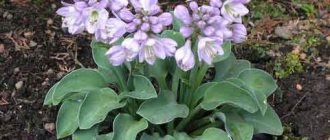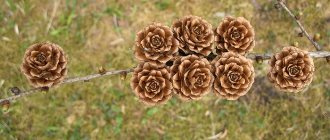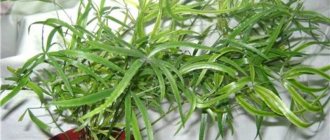Caring for Nepalese cinquefoil
The Western Himalayas and Nepal are considered the homeland of this flower, where numerous specimens are still found in natural conditions. Nepalese cinquefoil is a perennial plant with tall, well-branched purple stems that can grow up to 50 cm in height under natural conditions. The palmate leaves, similar to an animal's paw, are quite large and can reach 30 cm in length. The color of the leaf depends on the soil in which the cinquefoil grows and can vary from light green to dark with almost black veins. Flowering lasts two months. Five-petalled flower 3 cm in diameter, light pink or red.
Nepalese cinquefoil will do well in a sunny flower bed
All types of cinquefoil grow best in bright sunlight. Nepalese cinquefoil is no exception. Moreover, the flowers of the plant in cloudy weather, that is, in the absence of sunlight, do not even open completely. Planting in the shade is unacceptable for this flower.
Nepalese cinquefoil is a winter-hardy plant. However, in regions with a harsh climate, where temperatures drop below -25 degrees and there are frequent thaws, it is recommended to cover cinquefoil plantings with spruce branches, dry leaves or agrofibre.
Plants are most decorative on loose and nutritious soils with plenty of lime. Although cinquefoil can grow on any soil. In dry spring and summer, the flower requires regular watering, at least 2-3 times a week.
To ensure that the crop blooms profusely, do not allow the soil around it to dry out.
For abundant flowering, cinquefoil should be fed three times a season with organic fertilizers for flowering plants:
- the first feeding is carried out in early spring, when the snow has melted;
- the second time - at the time of budding in mid-May;
- The third feeding is applied after flowering in August.
Attention! Early spring is the best time to plant cinquefoil seedlings. But replanting can be done even after flowering.
Cinquefoil planting and care
To decorate a garden in any style without much effort, the charming cinquefoil is useful; planting and caring for it is more of a pleasure than a difficult task. And most importantly, the plant will bloom from the beginning of summer until the October frosts.
Potentilla bushes first appeared in flower beds in the 18th century. Even then they appreciated the plant’s unpretentiousness, amazing survival rate, and the beauty of delicate inflorescences with soft leaves and a “fluffy” center, decorated with many stamens.
Depending on the species and variety, cinquefoil will delight you with yellow, white, red, and bright orange shades of flowers. The size and color saturation of the leaves and, accordingly, their use in landscape design also differ.
There are types of cinquefoil: groundcover, herbaceous, shrubby, perennial and annual.
Kuril tea is the common name given to the bush cinquefoil (Dasiphora fruticosa). The species was first found on the Kuril Islands. There, the leaves of the plant, unusually rich in vitamin C, tannin and essential oils, were brewed and used as a vitamin drink, especially for colds.
In addition to Kuril tea, varieties of such species as white cinquefoil (Potentilla alba) and Nepalese cinquefoil (Potentilla nepalensis) are widely cultivated.
Planting Nepalese cinquefoil
Planting cinquefoil in your garden plot is not at all difficult. Follow this sequence:
- Prepare a planting hole at least 60 cm deep. If you are planting several plants, then keep a distance of at least 30 cm between them.
- Line the bottom of the hole with drainage; large pieces of brick, gravel or river sand will do.
- Fill half of the hole with a soil mixture of sand, humus and leaf soil in a ratio of 1:2:2.
- Plant a cinquefoil seedling in the hole, but leave the root collar above the soil level. Cover the planted plant with ordinary soil.
- After this, water all the plantings and do not allow them to dry out over the next three weeks.
Young plant
In the spring, before the leaves bloom, the cinquefoil needs pruning. In this way, fairly neat crowns will be formed, and flowering will be abundant.
Reproduction methods
Cinquefoil reproduces by seeds or vegetatively. Seed propagation is most effective for species plants, since varietal characteristics are not transmitted to future generations. It is recommended to grow seedlings first. To do this, at the end of March, seeds are evenly distributed into pots with sandy-peaty soil. They are germinated under film at a temperature of +18…+22°C. With the emergence of seedlings, the shelter is removed. Flowering of seedlings occurs after 2-3 years.
Large plants can be divided into several parts. This is done in the fall, before the onset of cold weather. The bush is completely dug up and the rhizome is cut into sections so that each has 1-2 growth points. The cut areas are sprinkled with crushed ash and, without allowing the roots to dry out, the cuttings are distributed over new planting holes.
Cuttings give good results. In June-July, green shoots about 15 cm long are cut. The lower leaves on them are removed, and the cut is treated with Kornevin. Planting is done immediately in open ground, in a shaded place. For 2-3 weeks, while rooting is taking place, it is recommended to cover the cuttings with film or glass jars. Every day the cover is removed and the plants are sprayed.
Since the stems independently take root where they contact the ground, varieties with creeping shoots are easily propagated by layering. It is enough to slightly damage the bark and sprinkle the sprout with soil. The top is left on the surface. The cuttings are watered regularly. The rooting process takes up to a month, after which the plant can be separated and transplanted to a new location.
Common varieties of Nepalese cinquefoil
As a result of selection, the following decorative varieties of Nepalese cinquefoil were bred:
- Variety "Miss Wilmont". The variety is distinguished by large flowers of rich pink color, collected in paniculate inflorescences. Seeds of this variety are sold in many flower shops, especially in spring. They are sown for seedlings in early spring. Shoots usually appear after 2-3 weeks. The variety is unpretentious and frost-resistant.
Variety "Miss Wilmont"
- Variety "Flower Carpet". The flowers are coral in color, with a richer center. Flowering lasts from June to September. For lush, abundant flowering you need a lot of sunlight. The variety easily adapts to any soil. Frost-resistant.
- Variety "Floris". The variety is medium-sized. The flowers are light pink with a bright pink spot at the base of each petal. An unpretentious and frost-resistant variety.
A little about the plant
Herbaceous perennial cinquefoil are hybrids, up to 800 mm high and with a scattering of bright flowers, up to 50 mm in diameter. For crossing, 3 species of plants of the same genus Potentilla (cinquefoil) were used:
- nepalensis - Nepalese;
- agrophylla - a plant with silvery foliage;
- atrosanguinea - the flowers of this species are dark red.
Advice! Frame groups of daylilies, daisies or bells with cinquefoil - this juxtaposition will make your flower garden very attractive. Potentilla looks good on an alpine hill and in a rock garden.
Before planting, you need to take care of preparing the planting material. Let's look at this question in more detail.
Propagation of Nepalese cinquefoil
Nepalese cinquefoil, like other perennial plants, is propagated by several methods: dividing rhizomes, green cuttings or seeds.
The most common and fastest method of vegetative propagation is division of rhizomes. In spring or autumn, the cinquefoil bush is dug up and the rhizome is divided into several parts with sharp pruners. All received Nepalese cinquefoil seedlings are immediately planted in a permanent place, following the sequence described above.
Seedlings of Nepalese cinquefoil
The method of propagation by green cuttings is more complex and less effective. In June-July, select green, elastic and well-ripened green shoots. Cut and prepare cuttings from them with two or three internodes and a length of 4-6 cm. Plant in a container with fresh fertile soil and cover with plastic wrap. Cuttings take a very long time to form roots: planted in June, they take root only by September. After growth appears on the rooted cuttings, they are transplanted to a permanent place in the flower garden.
The easiest way is to propagate by seeds. They are sown at any time, but the seedlings bloom only in the second year after planting.
Planting a plant
Cinquefoil Red Ice - description, planting and care
You can plant Nepalese cinquefoil at any time: from early spring to autumn, when it is warm. When planting, it is important to consider the basic requirements:
- presence of sun;
- lack of close occurrence of groundwater.
Note! Nepalese beauty grows beautifully next to clematis.
Planting from seeds
Growing the plant is not at all difficult, since the crop is unpretentious to its growing conditions: soil, location.
Seeds are collected independently or purchased in a store. Germination persists for at least 2 years. The seed material is small, so planting is carried out superficially. Spread into slightly moist soil and cover with a thin layer of earth or sand.
Some gardeners grow seedlings first
Seeds are sown 2–2.5 months before planting in open ground.
Further actions:
- When grown at home, the sown seeds are covered with plastic film or glass to retain moisture and heat. In 2 weeks the seedlings will sprout.
- Containers with sprouts are placed in a cool room (no more than 18 ° C), watered after 2 days.
- After 1.5–2 months, the seedlings dive. Since the roots are very small, you need to do everything carefully so as not to damage them.
Note! The growth of the plant does not depend on the fertility of the soil, but in acidic and heavy soil the cinquefoil will not produce lush flowering.
Planting seedlings in open ground
When warm weather is firmly established, the seedlings are transplanted to the site:
- Choose a sunny place where water does not stagnate. Nepalese cinquefoil and clematis are good neighbors. Nepalese bushes protect capricious vines from the hot rays of the sun.
- Plant in holes, maintaining a distance of at least 30 cm.
Cinquefoil is planted at any convenient time: from May to September.
Diseases and pests of Nepalese cinquefoil
All types of cinquefoil are rarely susceptible to disease or pest attack. However, with improper care, in particular excessive watering, the plant can be susceptible to a fungal disease called rust. To combat the disease, systemic fungicides are used.
Armyworm caterpillar Attention! Excessively moist soil often causes rotting of the root collar and small feeding roots, which often leads to the death of the entire plant.
The main enemy of cinquefoil is considered to be cutworms, whose caterpillars eat the green leaves and flowers of the plant. Twice treating the ground part with an insecticide solution will help eradicate them.
Bloodroot
Cinquefoil (Potentilla) is a beautiful and delicate flower from the Rosaceae family. This plant can be either herbaceous or shrubby. Shrubby cinquefoil is popularly called cinquefoil or Kuril tea. Some varieties of cinquefoil have medicinal properties, but more often this plant is more often used to create interesting landscape designs. Cinquefoil is great for decorating borders, alpine hills or hedges. It is very popular among gardeners due to its simultaneous combination of unpretentiousness and extraordinary beauty.
Use in landscape design
Nepalese cinquefoil is good as a single crop on alpine hills, in gardens among stones or as a border plant. But its flowers also look good surrounded by many low-growing plants, such as bells and speedwells. By planting in a row, you can make a small hedge from plants and enclose a flower bed with it.
Beneficial features
Due to the rich content of essential oils and vitamin C, the plant is used in folk medicine, especially for colds.
Cinquefoil Nepali, which is a shrubby perennial plant, is often used for growing at home in the garden. She will need a well-lit place and feeding at the end of the season. In return, the plant will reward you with long-term flowering of abundant flowers of bright colors. Nepalese cinquefoil Miss Wilmont looks especially elegant.
Due to its healing properties, the plant is used in folk medicine for various diseases, especially colds. And even an inexperienced gardener can grow cinquefoil.
Types of cinquefoil: photo
Cinquefoil Nepalese Miss Wilmont growing from seeds
Cinquefoil Miss Wilmont
Do its seedlings at the age of 2.5 months look like strawberry leaves? I must admit, I only saw this cinquefoil in a picture. The seeds sprouted well, I was already glad that I had acquired a new perennial, and suddenly a suspicion arose that it was not bloodroot at all. Well, typical strawberry leaves. Only in some of the basal rosettes, not three, but four or five lobed leaves began to appear. Sincerely,
| I_TT |
| Belarus Gomel |
| 30.05.2006 |
| 05:54:05 |
I don't know about Miss Wilmont, but Gibson's Scarlet cinquefoil leaves are very similar to strawberry leaves. I’ll write about how many blades they have after the weekend.
| Rulaman |
| Kazan |
| 30.05.2006 |
| 18:04:46 |
I_TT, when I planted cinquefoil seedlings several years ago, to be honest, I don’t remember the variety now, my mother was very happy that they had finally planted strawberries. I planted it in a border with daisies. Two years later, it captured the entire nearby territory, spread its legs 40 cm and was dug up and given to everyone.
| nataflori |
| Moscow |
| 30.05.2006 |
| 18:27:30 |
I_TT, Nepalese cinquefoil, which Miss Wilmont belongs to, really looks like strawberries in its leaves. And many herbaceous leaves are very reminiscent of strawberry leaves. So, the fears are in vain.
| Lara |
| Moscow |
| 30.05.2006 |
| 18:34:29 |
I have a brilliant cinquefoil growing in a strawberry with Baron Solemacher, Snow White and Zolotinka. (There are also duchesnea and sedum - I have a strawberry - a flowerbed). like many of the cinquefoils (by leaves I mean)
| KotD |
| St. Petersburg |
| 30.05.2006 |
| 19:15:23 |
I have Miss Wilmont's seed-grown cinquefoil. Yes, those are the leaves. In the first year after planting, it did not bloom for me; it was a small bush, very similar to a strawberry bush, about 30 cm in height. But don't let her fool you! Next year it will be a spreading bush with 50 cm long vines! I was stupid to plant it on the edge of the flower bed - it spread out over all the nearby plants. It is best to plant it where it will be alone, with the expectation that the long lashes from the wind and rain may lie on the ground and it will need to be tied up. So a good place for it is, for example, near the fence. But the plant is really unpretentious and beautiful.
| Nadezhda M. |
| Moscow |
| 30.05.2006 |
| 23:27:28 |
I_TT, last weekend I bought Miss Wilmont cinquefoil seedlings, they are an exact copy of strawberries. So I planted her on the lower tier of the alpine hill, and now after all the stories I think, did I do the right thing since she is so spreading?
| smallkat |
| Moscow |
| 31.05.2006 |
| 21:49:36 |
My Nepalese cinquefoil, grown from seeds, “in infancy” was very reminiscent of strawberries











